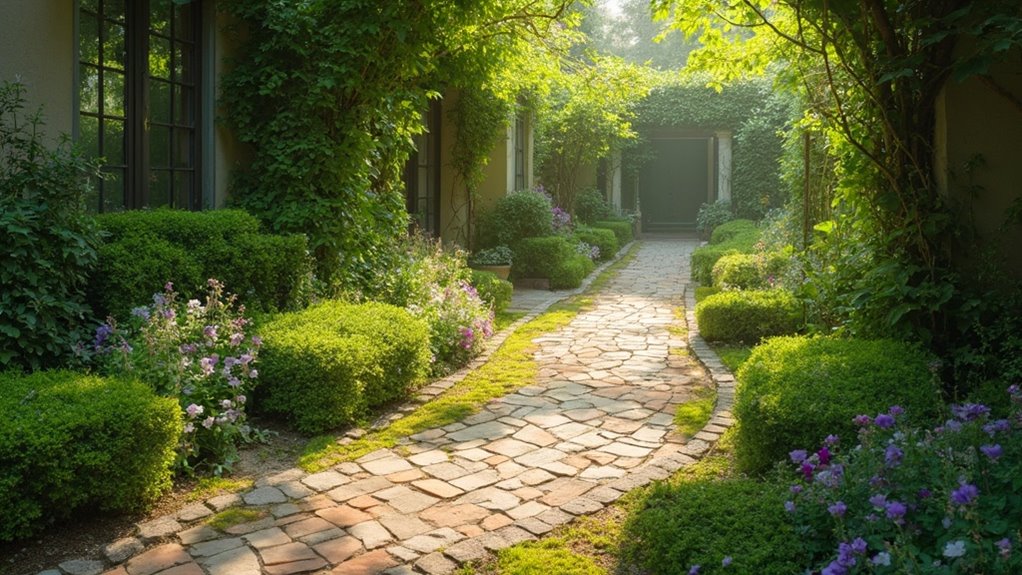There are inexpensive path and edging ideas to change up our entries! There are many options, from pea gravel paths to traditional concrete pads. Mulch and flagstone paths have a nice organic look, and compacted decomposed granite is durable. And don’t forget reclaimed bricks and paths made with pallets for that rustic touch. Both lanes are well drained and DIY-able. Stay tuned for more inspirations for sprucing up our outdoor spaces!
Table of Contents
Key Takeaways
- Explore cost-effective gravel pathways like pea gravel and compacted decomposed granite for attractive and functional entryways.
- Incorporate flagstone paths with grass or moss for a natural aesthetic that is durable and low-maintenance.
- Utilize concrete slabs for sleek designs that can be customized in size and shape to fit your garden style.
- Create unique stepping stone paths using reclaimed materials or personalized items for a charming, budget-friendly approach.
- Enhance pathways with edging made from wood or metal to maintain shape and improve overall appearance.
Stepping Stones and Mulch Path
If we are looking for a low cost option that will bring beauty to our gardens, a stepping stones and mulch path is a great option.
This inexpensive, do-it-yourself project has the permanence of stones and the organic quality of mulch, making for an inviting space. We can easily flagstone to keep mulch looking fresh and not shifting.
It is a soft surface that reduces weed growth and retains moisture, though we may want to plan on replenishing it as necessary.
Also, letting grass or ground cover grow between the stones is a nice and whimsical touch; our garden is meant to be natural.
Pea Gravel and Raised Bed Walkway
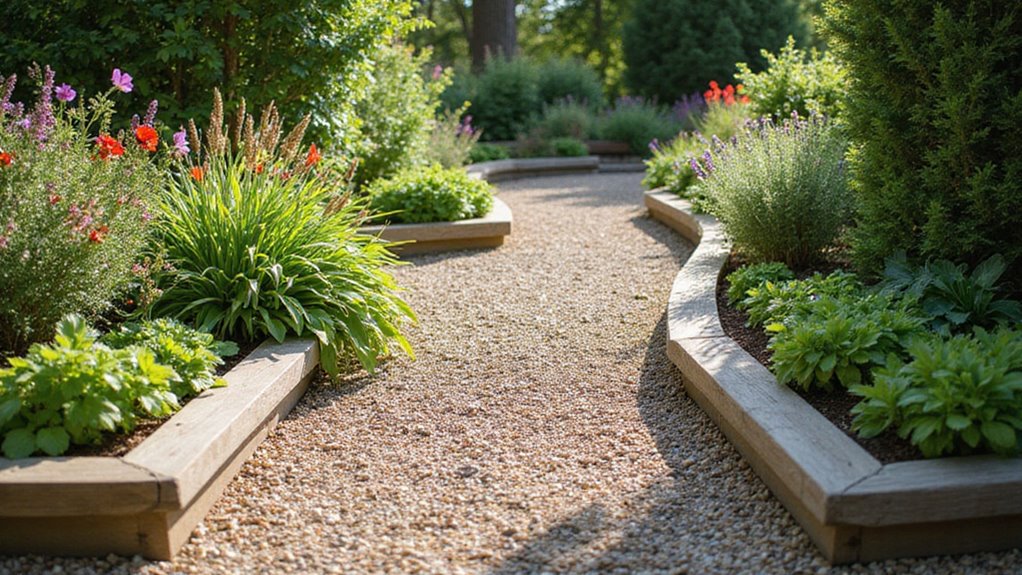
A pea gravel path will beautify our garden and provide a practical way to walk between raised beds and patios.
The natural appearance and clean lines of this inexpensive DIY garden path, which range from $1 to $3.15 a square foot, will work with many different types of gardens. Its drainage is phenomenal and it does not puddle, allowing for good moisture for our plants.
And we can install it ourselves! We like to add metal edging along the sides to keep the gravel in place and looking neat.
Let’s cover our yards with pea gravel and share garden paths!
Concrete Slab Path
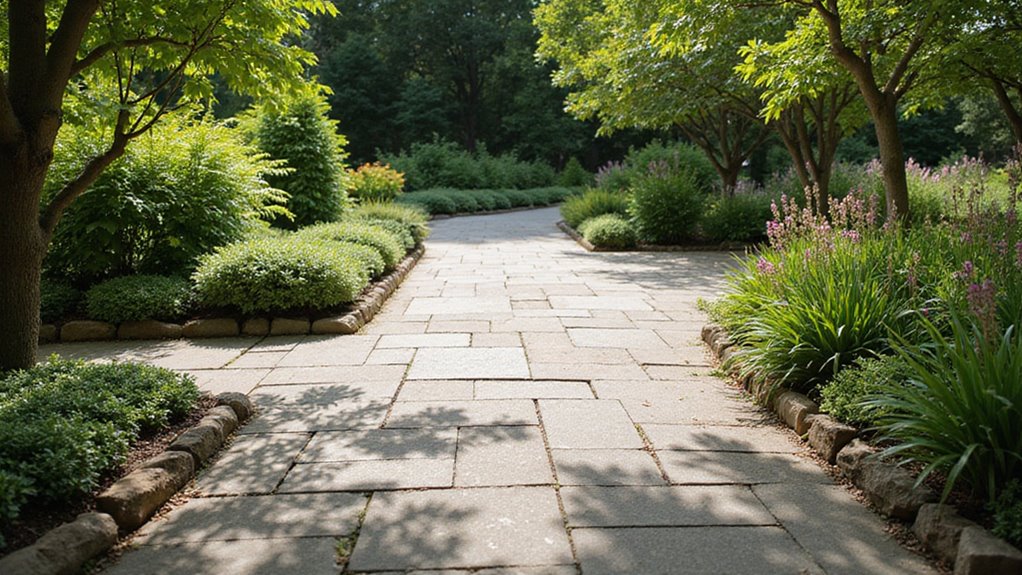
Pea gravel paths are adorable and rustic, and concrete slabs are a modern and lasting option for garden walkways.
These projects not only allow us to personalize shape and size, but also to create interesting features in our landscape.
Mixing and pouring concrete can be very tedious work, but it is cheap.
Let’s be reminded that it needs to cure, that we must wait 24-48 hours before walking on our new path.
Sealing the slabs will not only weatherproof them but will also add beauty for years to come.
Flagstone and Decomposed Granite Path
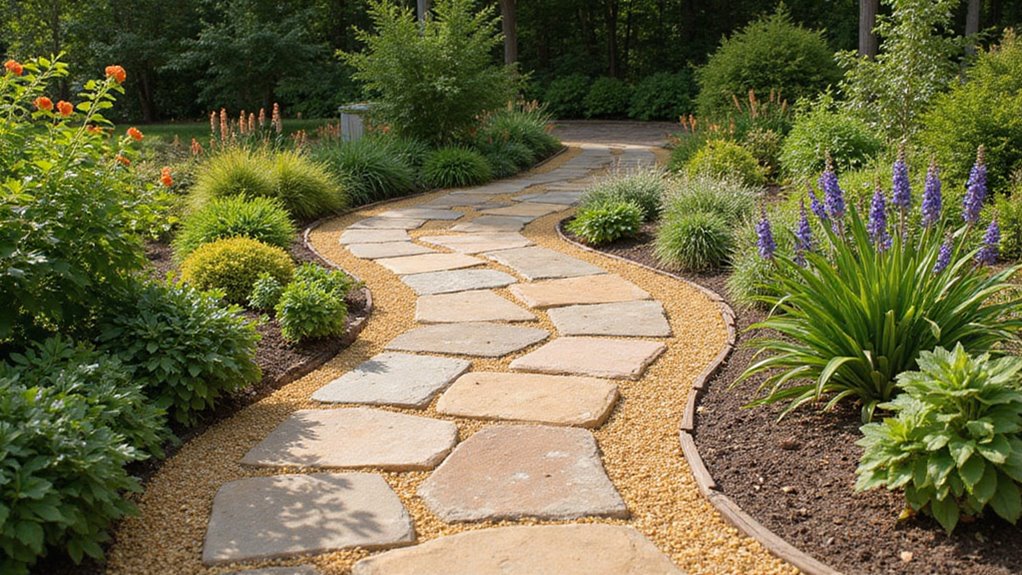
A flagstone and decomposed granite path is a perfect marriage of beauty and utility in our outdoor spaces.
With a durable surface material and a decomposed granite stabilizer, we can have a welcoming walkway that adds to our landscape. Not only is this project inexpensive, but it also can be made to suit our individual garden styles.
The decomposed granite fills the gaps between flagstones, providing a stable surface and improving aesthetics. It’s also low maintenance and simple to clean, making it a practical option for residential and commercial spaces.
Let’s make over our entryways with this gorgeous option!
Compacted Decomposed Granite Walkway
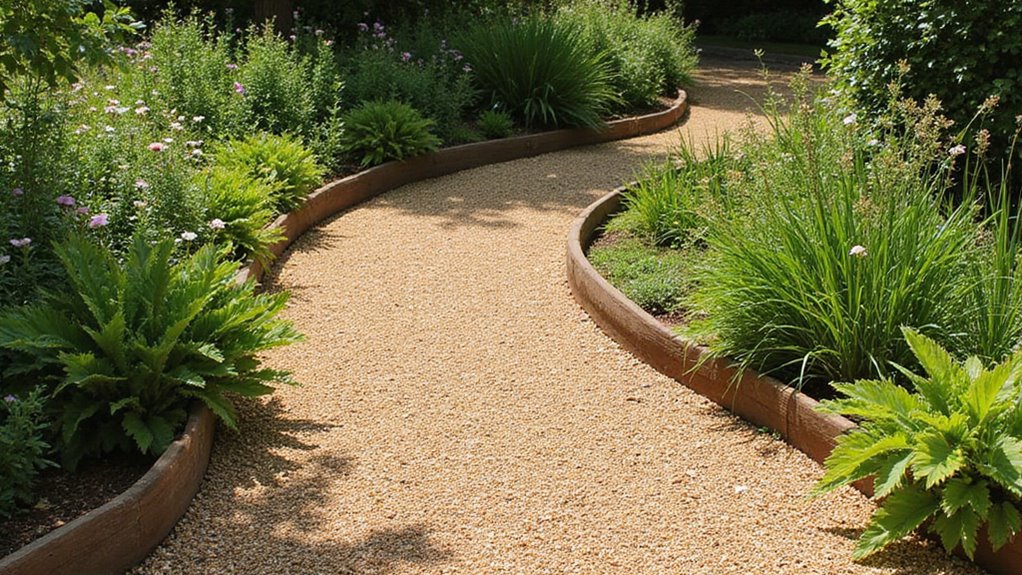
Complementing the appeal of flagstone and decomposed granite paths, compacted decomposed granite walkways are a neater, more natural option for our outdoor environments.
It is an inexpensive gravel, and has great drainage, which keeps our paths dry and usable. Installation is an easy do-it-yourself project; all that is required is a tamper or roller to compact the granite into a hard surface.
We can choose from several colors and our walkways can be customized to coordinate with our landscape. Wood or metal edging is used to help hold the granite in place and to shape it, and to beautify our gardens.
Lets make something beautiful!
Flagstone and Moss Garden Path
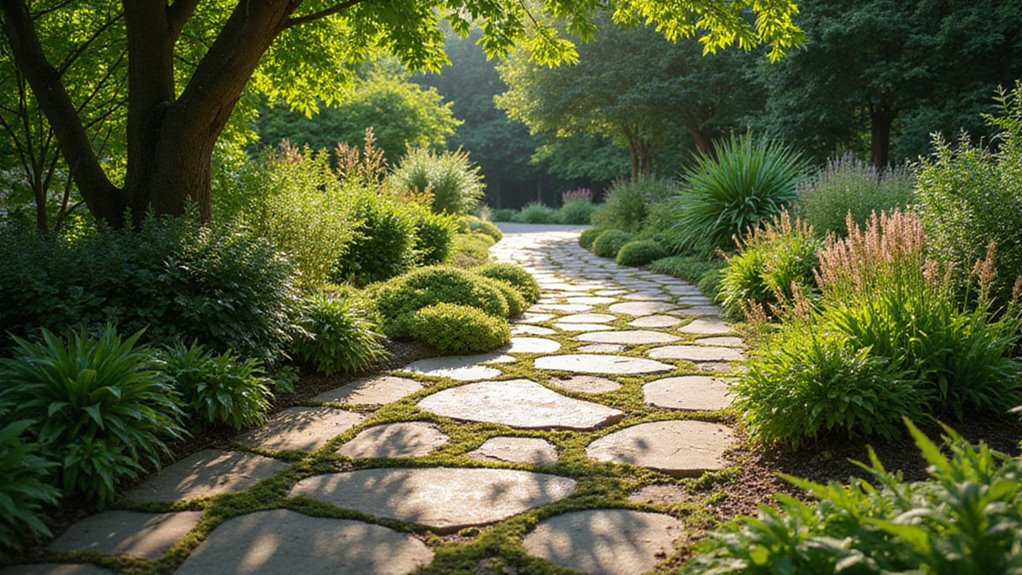
A flagstone and moss garden path can instantly beautify our outdoor areas and is a creative approach to incorporating nature into our landscape.
It’s a low-cost project that’s easy to install using few materials. The flagstone is durable and stable; the moss grows in the shade and fills the joints with a soft organic material.
Once it’s established, it needs little care other than watering and periodic clipping to keep it looking full.
Pebble and Brick Walkway
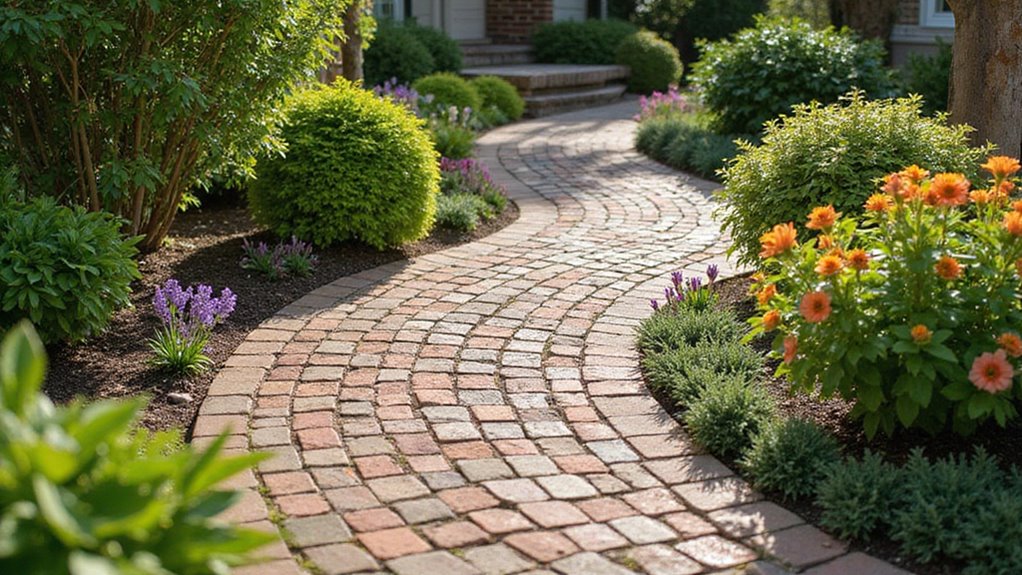
A pebble and brick path can beautify and improve our entrances and outdoor spaces. This combination combines the strength of brick with the beauty of pebbles for a classic look.
Bricks help to smooth out the slopes and provide a stable surface, while pebbles enhance texture and drainage. Regardless of whether we do it ourselves as a simple weekend project or bring in a contractor for a more elaborate design, it is cost effective.
The inexpensive materials, along with annual maintenance (replacing pebbles as necessary and resetting any displaced bricks), will ensure that our walkway will remain attractive and functional for many years.
It’s time to create our beautiful entryway!
Pea Gravel, Metal-Edged Path
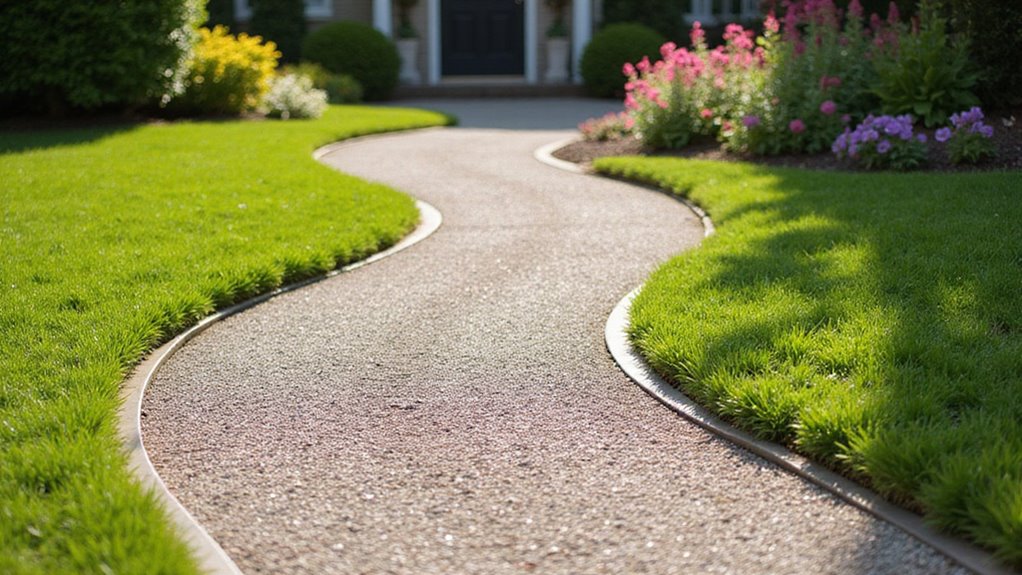
Gravel, especially pea gravel, is an attractive and inexpensive option for our outdoor areas.
Pea gravel is also inexpensive, costing between $1 and $3.15 per square foot, making it a great option for DIY garden path ideas. In addition to holding the gravel in place, the metal edging helps keep the gravel looking neat and prevents it from spilling into our garden beds.
This combination enables long lasting and attractive pathways that look clean and natural. It is an ideal option for those of us who want to spruce up our outdoor spaces on a budget and is easy to install.
So, let’s begin!
Flagstone and Grass Walkway
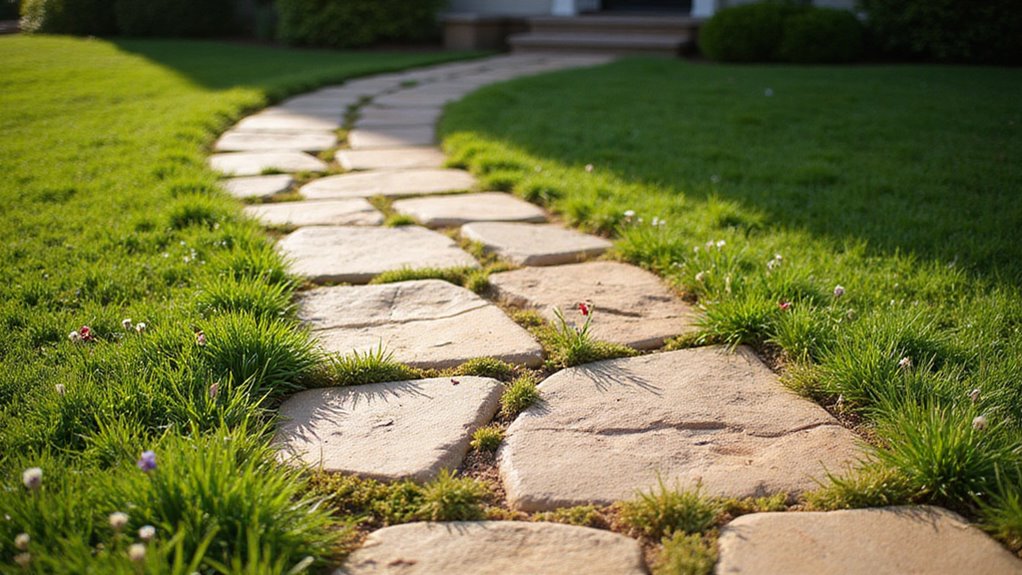
Until we figure out the best way to improve our outdoor areas, we have found a flagstone and grass walkway to be relatively permanent and welcoming.
These two elements form a natural path that integrates with our gardens. Consider some of the advantages:
- Durability: Flagstone withstands heavy foot traffic.
- Aesthetic Appeal: The lush grass softens the walkway’s appearance.
- Customization: We can choose different flagstone sizes and grass types.
- Low Maintenance: Regular mowing and occasional weeding keep it tidy.
Brick and Paver Mosaic Path
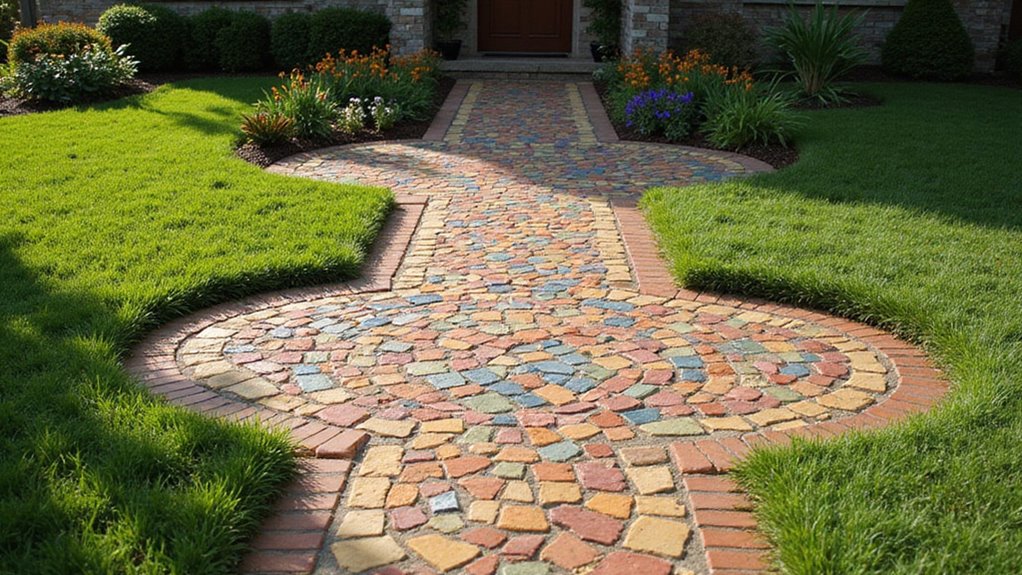
A beautiful mosaic brick and paver path can inspire our taste and enhance our outdoor space. Using different brick pavers will allow us to create interesting patterns on our entryways.
Yet it makes even a stone path magical. Available in colors such as red, tan and gray, our mosaic path complements any style of home, traditional or contemporary.
It is a bit of a project, costing $600 to $800, and you need some DIY skills, but its durability and vintage appeal make it a solid investment.
Let’s get creative and create our own path!
Classic Gravel Garden Path
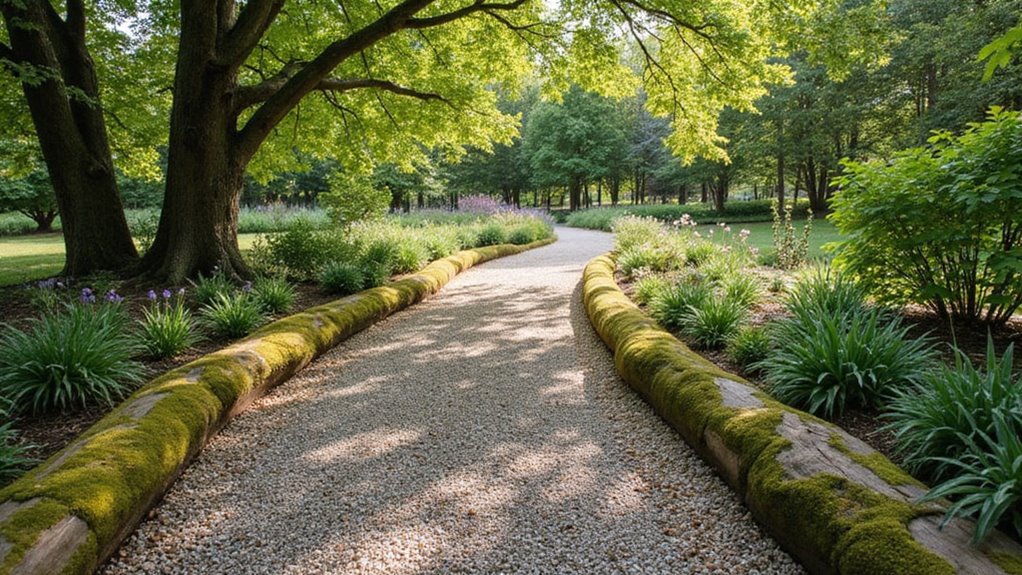
Gravel garden paths are a practical, inexpensive and attractive way to create a lovely outdoor space on a budget.
They cost between $1 and $3.15 a square foot. We get a rustic look that works with our landscaping too.
Here are four benefits of classic gravel paths:
- Easy DIY installation for a custom touch.
- Great drainage, which helps our plants thrive.
- Gray, tan and other colors to suit any decor.
- A weed barrier helps keep weeds from being an eyesore.
With these advantages, we can create beautiful pathways that won’t break the bank!
Gravel and Paver Garden Path
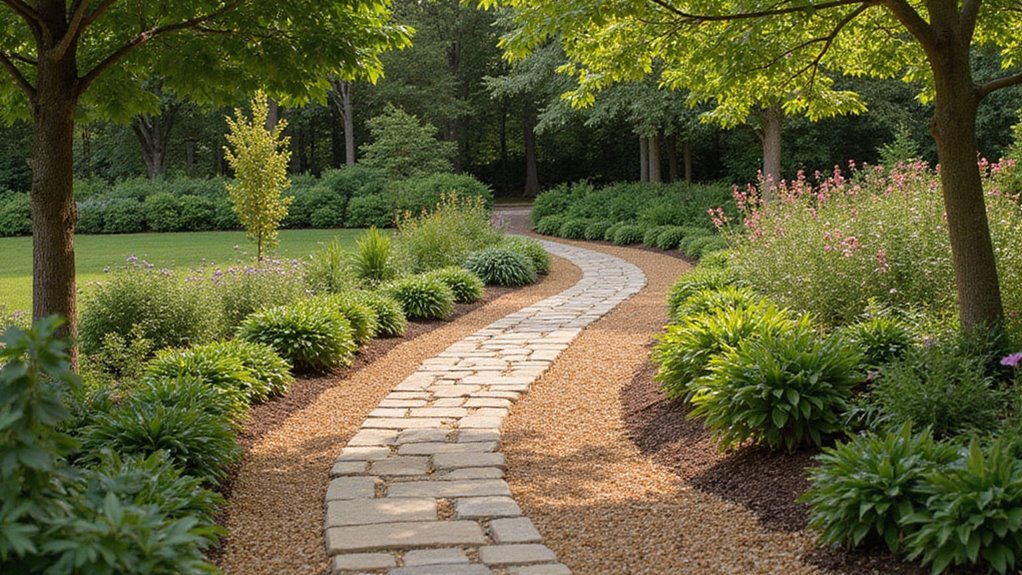
Gravel and pavers can work the same magic as a vintage gravel pathway to enhance our outdoor spaces. This stylish way of doing things allows us to have a functionally and aesthetically pleasing walkway.
The stone pavers are set on a solid base, with gravel in the joints to improve drainage and reduce maintenance. And it is affordable, usually running between $1 and $3.15 a square foot.
Compacted Decomposed Granite Stair Walkway
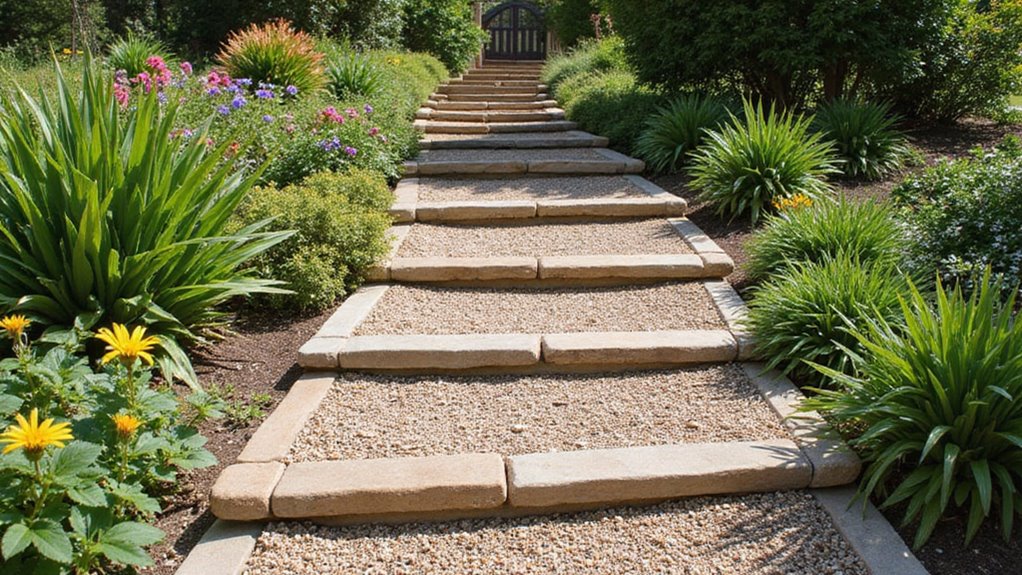
Walking on slopes in our gardens need not be difficult; consider the advantages of a compacted decomposed granite stair path.
This alternative provides a permanent and ornamental work surface. Here are four reasons to consider it:
- Budget-Friendly: Costs less than traditional paving stones.
- Excellent Drainage: Naturally porous, preventing water pooling and erosion.
- Easy Installation: With thorough compaction, it withstands foot traffic effortlessly.
- Regular Maintenance: Simple upkeep guarantees lasting beauty and functionality.
Not-So-Basic Brick
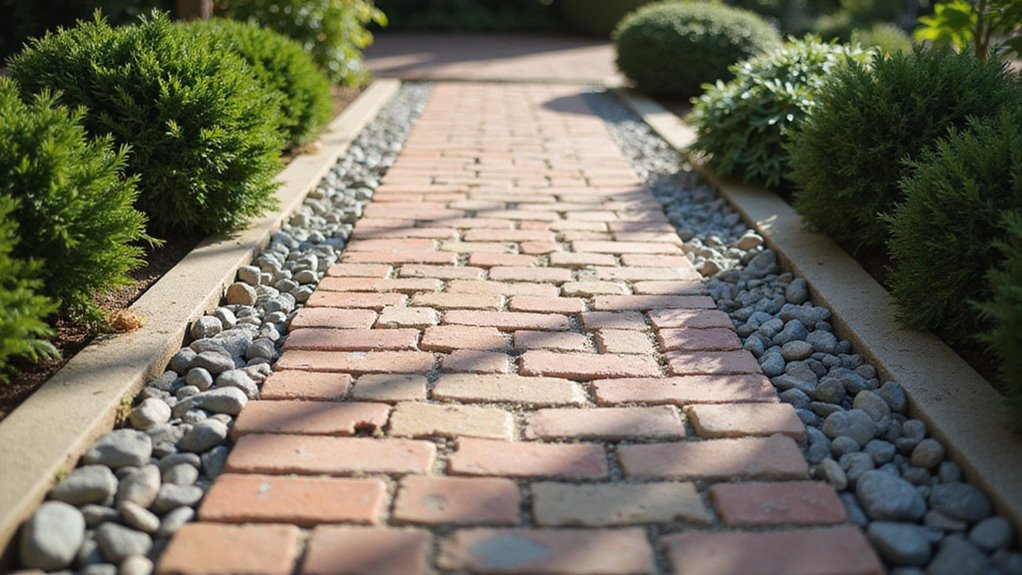
The durability and beauty of a brick path can enhance any garden.
When we choose brick pavers rather than bricks we improve durability and appearance.
Let’s use beautiful laying patterns such as bordered herringbone and running bond to make a gorgeous path that goes with our home.
We start with a gravel layer for stability, then sand for leveling before we lay down the bricks.
And doing the prep work ourselves saves on installation fees.
Go With Gravel
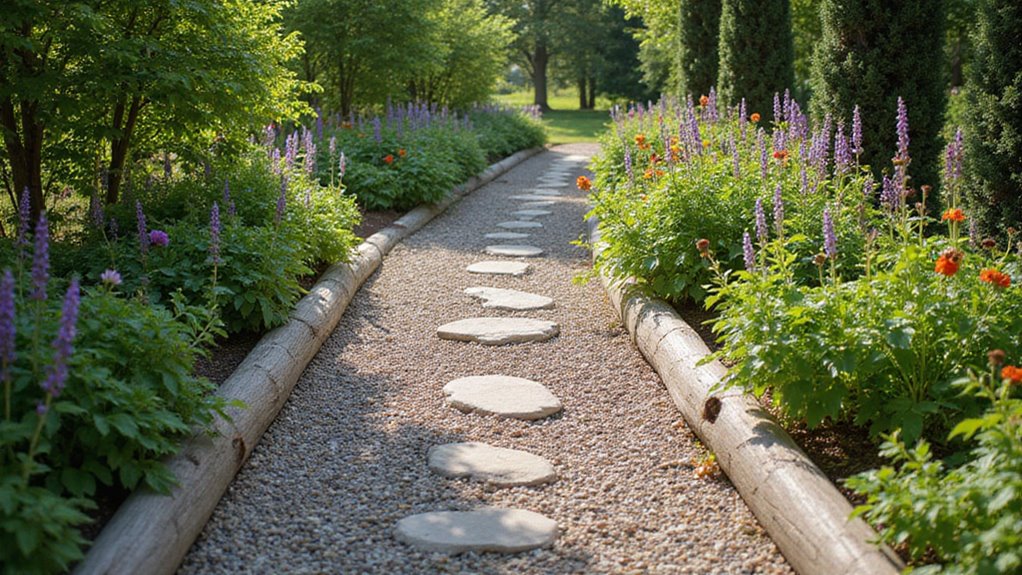
If you want to create garden paths that are inexpensive and attractive, gravel is a great option.
It is cheap, it drains well, and it is flexible.
Let’s explore how we can create stunning gravel paths:
- Set out the perimeter with stakes and string for straight lines or a hose for curves.
- Use crushed gravel, sand, and pea gravel for drainage and stabilization.
- Remember, the maintenance is easy, though we will need to replace gravel once in a while.
- Let’s put some gravel in our outdoor spaces for beauty and utility!
Eye-Popping Pebble Patterns
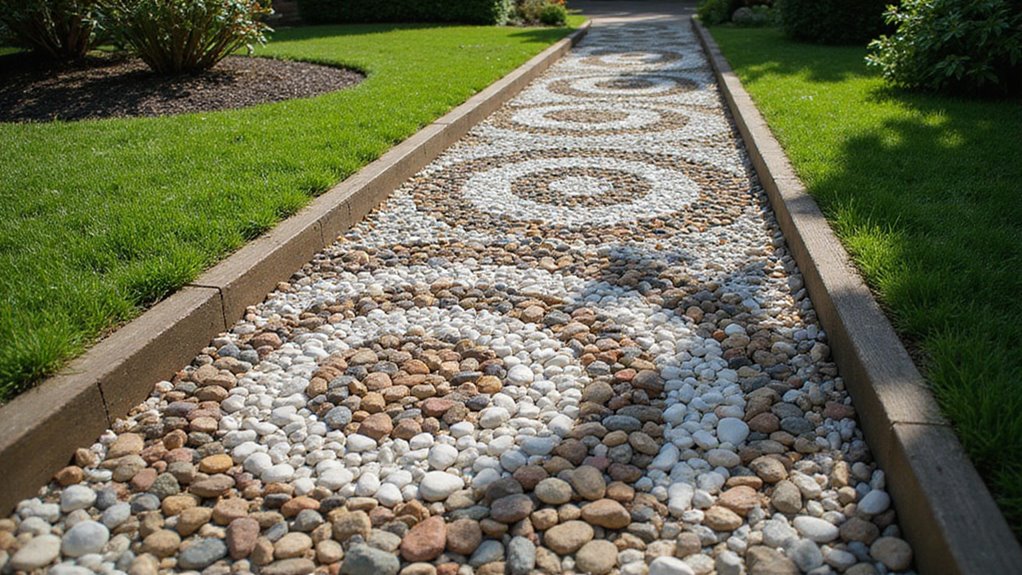
We can mix art and utility in the pebble patterns we create for our garden paths. Arranging pebbles in different mosaics provides an outlet for creativity as well as improving our outdoor spaces.
The pebbles can either be collected from nature or purchased, and they can be of various colors and sizes. The technique requires making a mold, pouring concrete and arranging the pebbles, resulting in beautiful works of art.
These pebble designs require time and care because they are both walkways and decorative features; they can be used as an attractive landscape element in any patio or garden.
Creative Concrete
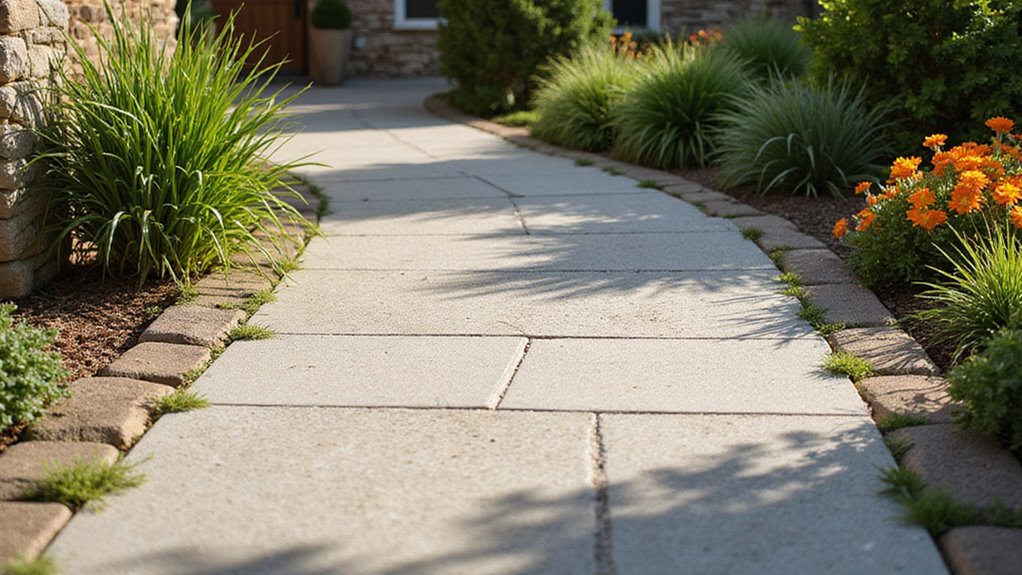
When it comes to thinking outside the box for our garden paths, creative concrete is a great possibility.
It is also versatile and low maintenance so we can have beautiful looks for less. Here are some ideas to inspire us.
- Stamping: Mimic stone or brick patterns with decorative techniques.
- Staining: Add vibrant colors that breathe life into our pathways.
- Painting with Doilies: Create intricate, lacy designs for unique visual flair.
- Custom Shapes: Pour concrete into personalized designs that suit our landscaping style.
Let’s use creative concrete for beautiful, long lasting paths!
Calling All Collectors
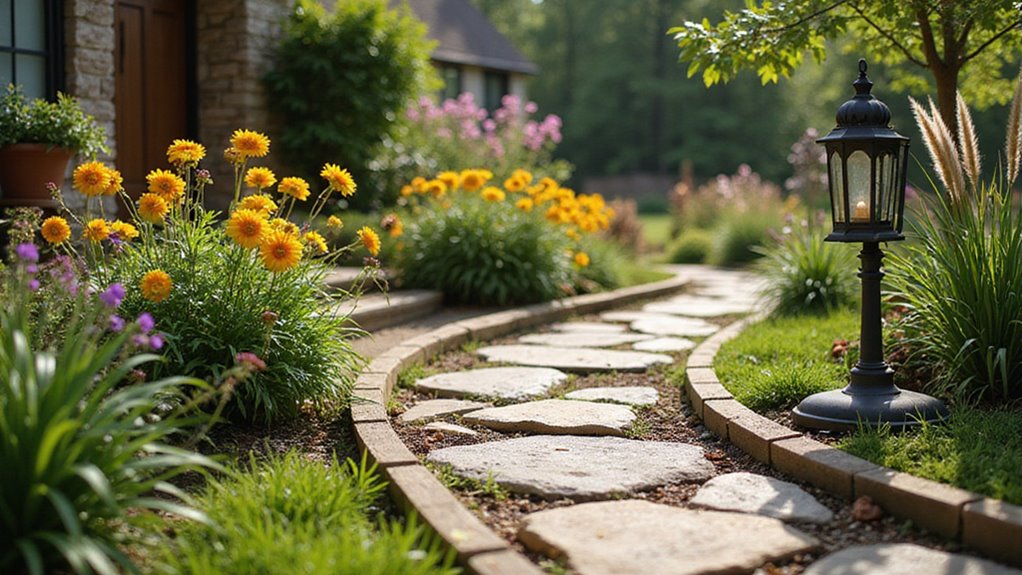
For those who collect, or for those just beginning to, using beloved found objects to line garden paths is one way to express our uniqueness.
Personalized stepping stones can be cast in plywood or concrete tube molds. If we place collected objects, such as seashells and pebbles, in these molds, we can cast them in concrete.
This is a DIY project that not only lends charm to our gardens, but is also a conversation piece that expresses our own style. The options in materials and colors for our pathways can produce beautiful patterns, and render our outdoor areas unique.
Thanks So Mulch
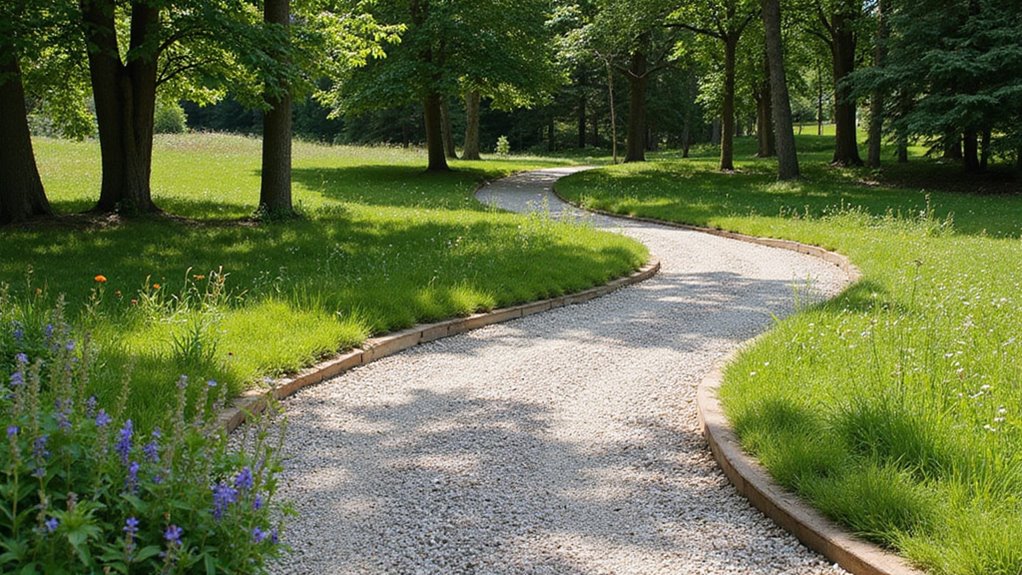
Mulch makes our gardens accessible and welcoming and is a pleasure to behold. Organic mulch provides a soft, natural path that visually integrates, while suppressing weeds.
Here’s how to create a stunning mulch path:
- Your choices of mulch: cocoa bean hulls, wood chips or cypress bark.
- Mark out and excavate the path you want, setting in edging.
- Add crushed stone on the bottom for drainage.
- Be sure to use your selected organic mulch in an area of low foot traffic, for maximum durability.
Not only is this sustainable, it also helps conserve moisture in the soil, and it is beautiful in our garden.
Let’s get mulching!
Brick on a Budget
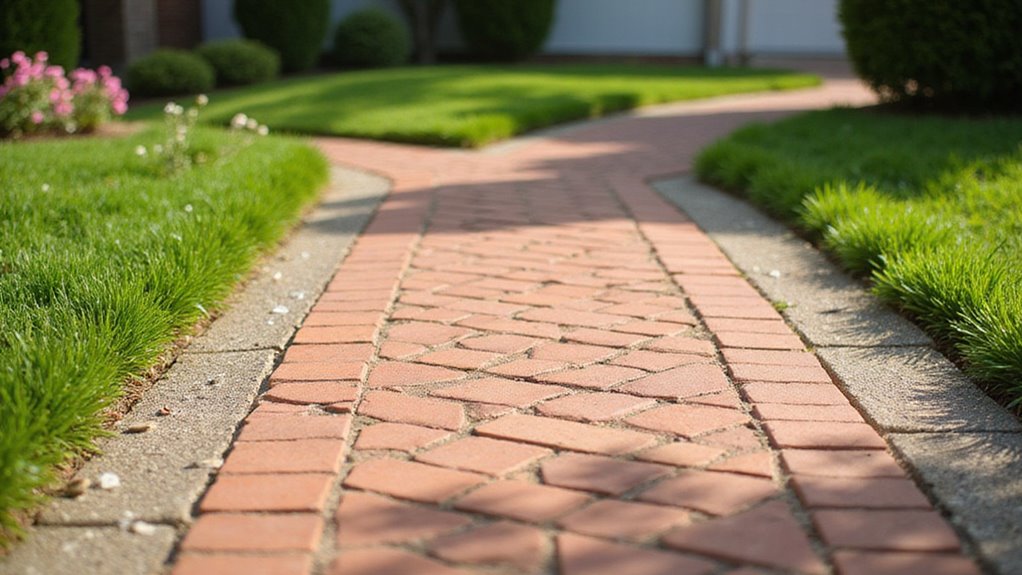
Once we have created inviting mulch paths, we can explore another inexpensive option that adds character and functionality to our gardens: brick paths.
Instead, salvaged red bricks can be an inexpensive way to add rustic warmth to our brick walkway. To keep it economical, let’s look at dry-laid patterns, which are less labor- and materials-intensive.
A gravel base will ensure that the brick paths will not shift over time. We can even jazz up the old designs with pretty laying patterns, like herringbone or basketweave, at no great cost.
Let’s get serious and estimate 5 bricks per square foot for our project!
Pallet Path
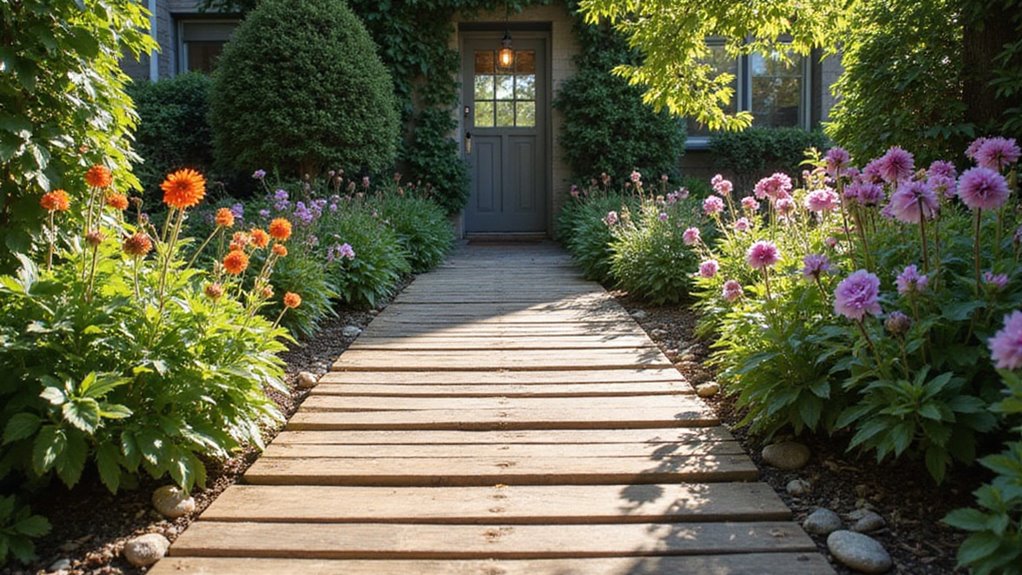
A pallet path can make our outdoor area a lovely getaway space at very little cost.
This eco-friendly landscaping choice uses reclaimed wooden pallets and has a bit of a rustic look.
Here’s how to create our own pallet path:
- Break down the pallets and sand the wood smooth.
- Seal with polyurethane to protect from the weather.
- Lay the boards with spaces for drainage and soil.
- Choose treated pallets for rot resistance and durability.
Sand and Stone
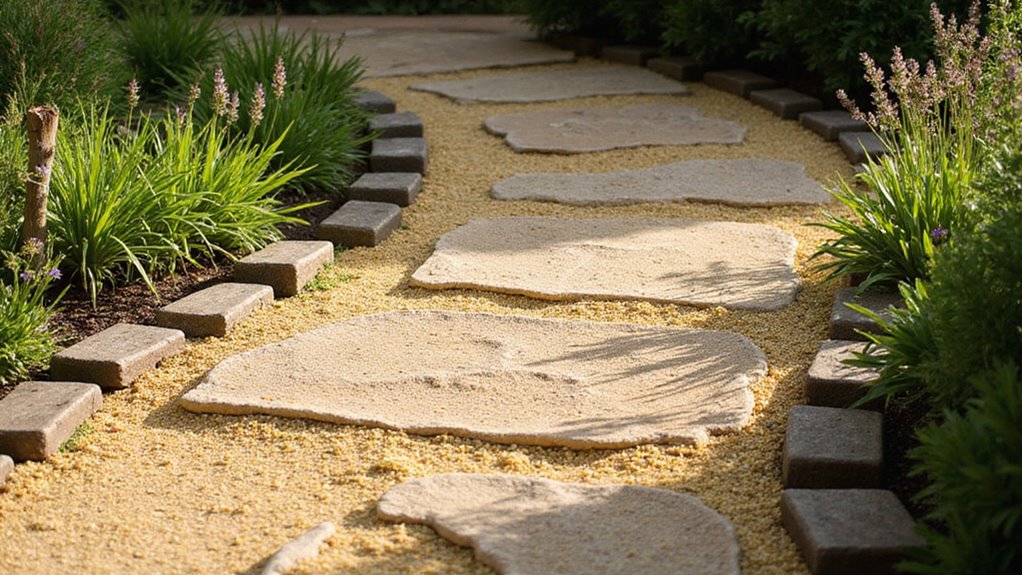
Sand and stone paths can be a refreshing and cost effective alternative to conventional poured concrete paths, and can add a natural beauty to our outdoor environments.
Sand under our stones provides a solid foundation and also helps with drainage and puddling. The use of multiple stones has a rustic quality, the sand between the stones keeps them in place and is easy to maintain.
This is a totally doable weekend project that can provide us with a beautiful path for a minimal cost.
Let’s change our outdoor spaces together!

